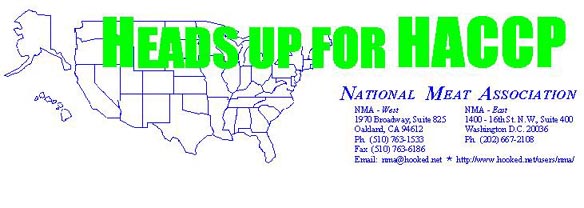
Edited by Kiran Kernellu
December 9, 2002
�
HOW TO MEET THE E. COLI O157: H7 REASSESSMENT REQUIREMENTS
�
The U.S. Department of Agriculture�s Food Safety and Inspection Service (FSIS) is requiring plants to reassess their HACCP plans for raw beef products to ensure they adequately address the control of E. coli O157: H7.� FSIS was prompted to require this action in light of new data that shows E. coli O157: H7 is more prevalent than previously thought according to two published studies (Elder/Smith).� All plants with beef production will need to reassess their HACCP plans accordingly based on the new E. coli O157: H7 data. Large plants (all establishments with 500 or more employees) are required to reassess by December 6, 2002; small plants (all establishments with 10 or more employees but fewer than 500) by February 4, 2003; and very small plants (all establishments with fewer than 10 employees or annual sales of less than $2.5 million) by April 7, 2003.
�
Plants will need to address several FSIS concerns while conducting their reassessment of their HACCP plans.� One of the most important issues a plant must consider in their reassessment is whether the plant has ever had a positive for E. coli O157: H7. If not, then it is important to address whether this pathogen is reasonably likely to occur and contaminate the product �in the absence of control�.� FSIS will very closely investigate and question plants that decide, after they do a reassessment, that they do not need any further measures to control E. coli O157: H7.� Another important part of the reassessment is to collect all the necessary supporting documentation for the revised HACCP plans.� Each component of the HACCP plan will need to be reviewed and revised accordingly for compliance.
�
There are several measures beef slaughterers and deboning establishments must consider during the reassessment of their HACCP plans.� Beef slaughterers will need to identify E. coli O157: H7 in their hazard analysis as a hazard reasonably likely to occur at one or more of their process steps.� If such establishments have controls in place to address E. coli O157: H7 specifically, they cannot conclude that the pathogen is not a hazard reasonably likely to occur in the absence of those controls.� Thus, FSIS believes that any interventions that slaughter and deboning establishments use to address E. coli O157: H7 should be incorporated into their HACCP plans as CCPs.�
�
Interventions include: acid washes, hot water washes, steam pasteurization, and steam vacuuming.
�
Grinders should strongly consider requiring a certificate of analysis (COA) from their supplier for E. coli O157: H7, if they do not already have one. The COA�s main purpose is to demonstrate that the supplier is using validated interventions to prevent or minimize the growth of E. coli O157: H7.� In order to verify the adequacy of the COA, the grinder should conduct their own testing of either the raw or finished product with negative E. coli O157: H7 test results.� Manually verification that the COA for the corresponding lot has been tested and found negative for E. coli O157: H7 is also essential.� Grinders may also incorporate purchase specifications into their prerequisite program in lieu of having a CCP in their HACCP plan.� Unfortunately, testing cannot completely guarantee that the product is free from E. coli O157: H7 adulteration.� Grinders should also maintain records that would allow a trace back to suppliers and trace forward to customers in the event of a positive for E. coli. O157: H7.
�
Plants must be able to demonstrate to the Agency that they have reassessed their HACCP plan in accordance with the regulatory requirements.� To verify that a reassessment has taken place documentation is necessary.� Documentation should include all aspects of the reassessment including: who was involved with the reassessment and their role, material reviewed for the reassessment, and what decisions resulted in revisions, or no revisions, to the HACCP plan, SSOPs or prerequisite program.� All records, notes, supporting documentation and decision-making documentation must be made available for FSIS review.
�
Last but not least, remember to sign and date the newly reassessed HACCP plans!
�
The purpose of Heads Up For HACCP is to provide straightforward technical information about HACCP and the scientific principles on which it is based so that company employees and regulatory employees can better understand the inspection system changes that are now in the process of implementation. Back issues are available at NMAonline.org.
�
�
PLEASE DISTRIBUTE TO. . .
����������� Plant employees, Foremen, Quality Control personnel and FSIS inspectors.